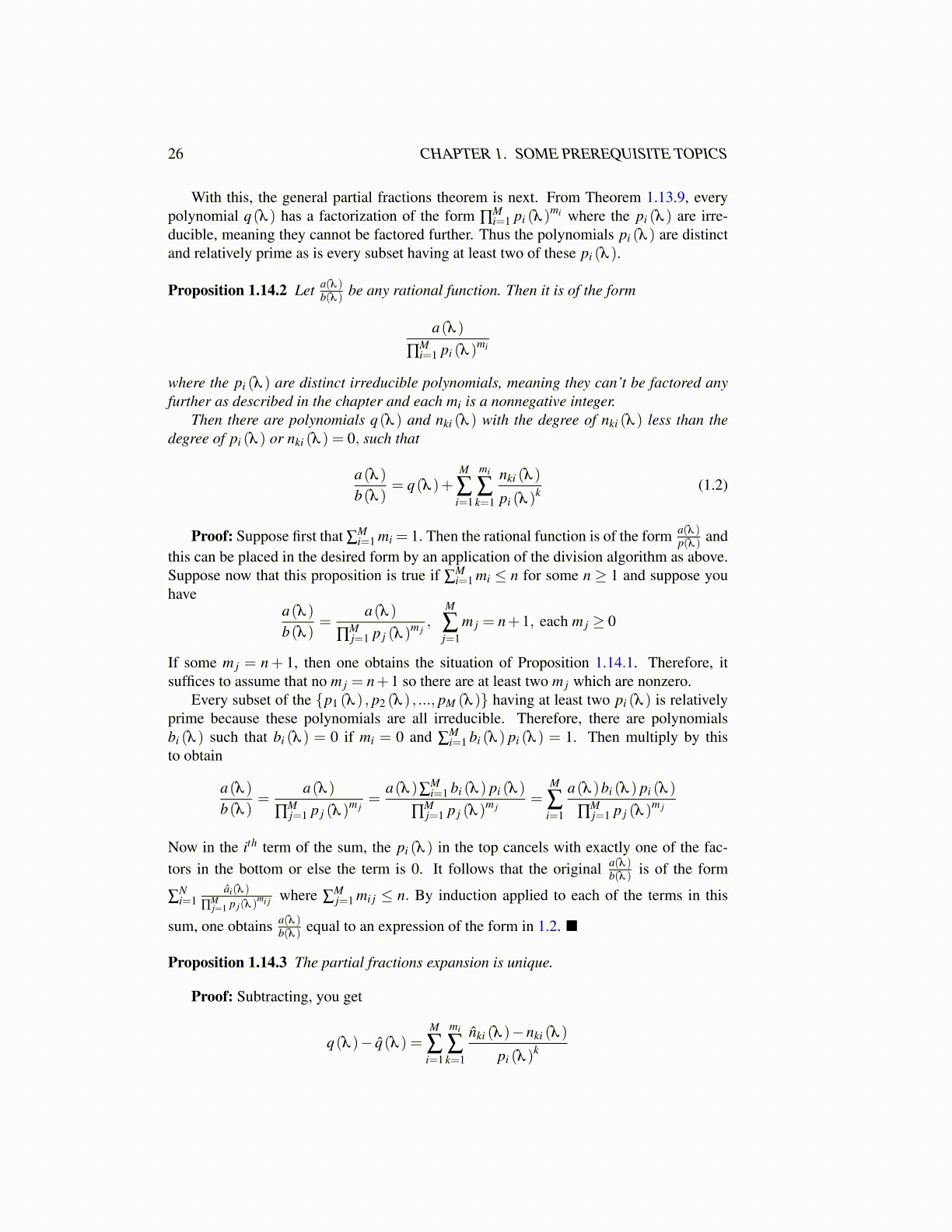
26 CHAPTER 1. SOME PREREQUISITE TOPICS
With this, the general partial fractions theorem is next. From Theorem 1.13.9, everypolynomial q(λ ) has a factorization of the form ∏
Mi=1 pi (λ )
mi where the pi (λ ) are irre-ducible, meaning they cannot be factored further. Thus the polynomials pi (λ ) are distinctand relatively prime as is every subset having at least two of these pi (λ ).
Proposition 1.14.2 Let a(λ )b(λ ) be any rational function. Then it is of the form
a(λ )
∏Mi=1 pi (λ )
mi
where the pi (λ ) are distinct irreducible polynomials, meaning they can’t be factored anyfurther as described in the chapter and each mi is a nonnegative integer.
Then there are polynomials q(λ ) and nki (λ ) with the degree of nki (λ ) less than thedegree of pi (λ ) or nki (λ ) = 0, such that
a(λ )b(λ )
= q(λ )+M
∑i=1
mi
∑k=1
nki (λ )
pi (λ )k (1.2)
Proof: Suppose first that ∑Mi=1 mi = 1. Then the rational function is of the form a(λ )
p(λ ) andthis can be placed in the desired form by an application of the division algorithm as above.Suppose now that this proposition is true if ∑
Mi=1 mi ≤ n for some n ≥ 1 and suppose you
havea(λ )b(λ )
=a(λ )
∏Mj=1 p j (λ )
m j,
M
∑j=1
m j = n+1, each m j ≥ 0
If some m j = n+ 1, then one obtains the situation of Proposition 1.14.1. Therefore, itsuffices to assume that no m j = n+1 so there are at least two m j which are nonzero.
Every subset of the {p1 (λ ) , p2 (λ ) , ..., pM (λ )} having at least two pi (λ ) is relativelyprime because these polynomials are all irreducible. Therefore, there are polynomialsbi (λ ) such that bi (λ ) = 0 if mi = 0 and ∑
Mi=1 bi (λ ) pi (λ ) = 1. Then multiply by this
to obtain
a(λ )b(λ )
=a(λ )
∏Mj=1 p j (λ )
m j=
a(λ )∑Mi=1 bi (λ ) pi (λ )
∏Mj=1 p j (λ )
m j=
M
∑i=1
a(λ )bi (λ ) pi (λ )
∏Mj=1 p j (λ )
m j
Now in the ith term of the sum, the pi (λ ) in the top cancels with exactly one of the fac-tors in the bottom or else the term is 0. It follows that the original a(λ )
b(λ ) is of the form
∑Ni=1
âi(λ )
∏Mj=1 p j(λ )
mi j where ∑Mj=1 mi j ≤ n. By induction applied to each of the terms in this
sum, one obtains a(λ )b(λ ) equal to an expression of the form in 1.2. ■
Proposition 1.14.3 The partial fractions expansion is unique.
Proof: Subtracting, you get
q(λ )− q̂(λ ) =M
∑i=1
mi
∑k=1
n̂ki (λ )−nki (λ )
pi (λ )k